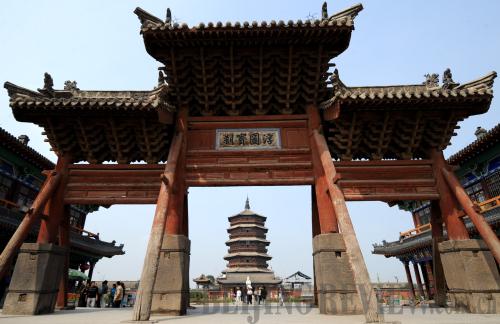|
 |
|
A wodden gate in front of the Sakyamuni Pagoda in Yingxian County, Shanxi Province (YAN YAN) |
Protection plan
"Despite all the wonders of the pagoda, it's still not in very good condition," said Ma. "After almost 1,000 years, even stone would have a mark, not to mention a building made entirely of timber."
Ma said the second floor of the pagoda is the main bearing floor, but it is in the worst condition. Thirty of the total 32 pillars of the floor are in serious danger. Now, only the first and second floors are opened to the public and only 20 people at a time are allowed to visit the second floor.
"The leaning angle of pillars is as much as 10 degrees on the second floor and the degree is even more on the third floor," said Ma.
Since the 1990s, a team of experts on protection and restoration has been working to resolve the leaning problem. But, the final solution hasn't been chosen because the situation keeps getting more complicated, said Luo Zhewen, an expert with the State Administration of Cultural Heritage.
"Some say it's only necessary to support the leaning parts, others say the upper levels above the third floor should be supported; and some even argue the whole building should be dismantled and built again," said Luo.
"One of the possible solutions is to lift up the fourth and fifth floors and restore the second and third floors and then put the fourth and fifth floors back, but the problem is some pieces of the pillars have already been broken. If they are taken out, then why not change them with new wood and keep the old pieces in better condition," said Ma.
Ma says that to find out how the pagoda was built without any nails is also a key to its protection and a way to inherit the legacy. No matter which solution is adopted, the ancient pagoda needs urgent repair and protection if it is to stand for another 1,000 years. "The clock is ticking," said Ma.
On September 5, 2006, more than 1,000 Buddhists, including some from Taiwan, gathered in Yingxian County to join the prayer for the pagoda's 950th birthday and to see the relics discovered inside the pagoda's statues.
In May 2010, the first Sakyamuni Pagoda International Tourism Cultural Festival was held in the county, with an aim to introduce the pagoda to the whole world. In November 2010, the Shanxi Provincial Government officially started the application process for the world cultural heritage status.
The provincial government said they would finish the application for the wooden pagoda by July 2011, and the pagoda is expected to be included on the UNESCO list of cultural heritage by 2013.
"Since 2009, we have invested more than 30 million yuan ($4.6 million) in improving the environment around the pagoda," said Zhao Chang, director of the county's cultural relic department.
The development of the local tourism should not be achieved at the price of further damage to the pagoda," said Zhang Qi, Deputy Director of the Institute of Buddhism Culture of China, at a seminar about the wooden pagoda on May 12.
"The pagoda is of great architectural, religious and historical values and we should study more about its cultural background and do more than just focusing on the building itself," said Wen Jinyu, a professor of philosophy with Renmin University of China at the seminar. "About 75 percent of ancient wooden constructions of the Liao Dynasty are in Shanxi Now. They are great resources for both historical and architectural study."
If the wooden pagoda is added to the world's cultural heritage list, it will be the fourth property in the list of Shanxi Province. The other three are the ancient city of Pingyao, the Yungang Grottoes and the Wutai Mountain. | 